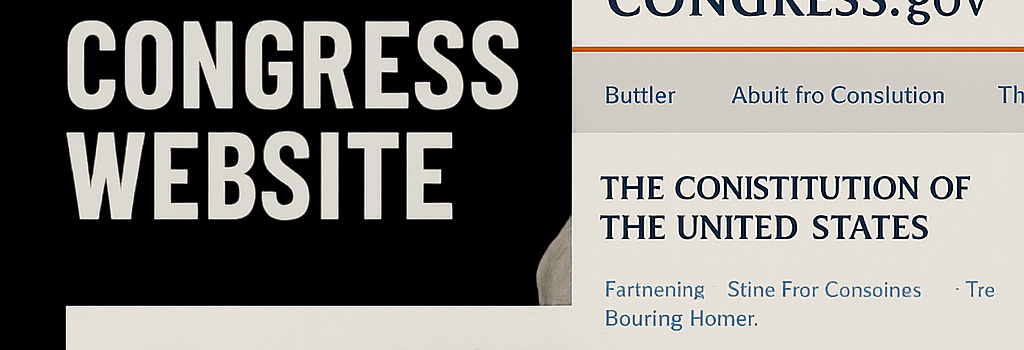Glitch Erases Key Constitutional Text from Congress Website

August 6, 2025 — A software deployment mishap at the Library of Congress temporarily removed critical portions of the U.S. Constitution from the Constitution Annotated portal. Internet users and researchers noticed missing text in Article I early Wednesday, prompting a rapid rollback and patch of the underlying content management system.
Incident Overview
Visitors to constitution.congress.gov began reporting gaps in Article I shortly after a routine update to the site’s back-end codebase. Approximately 650 words spanning Section 8 (partially) and all of Sections 9 and 10 of Article I were temporarily inaccessible. These missing passages included:
- Authorization for Congress to provide and maintain a Navy and call forth a Militia.
- The habeas corpus clause: “The Privilege of the Writ of Habeas Corpus shall not be suspended…”.
- Provisions forbidding bills of attainder and ex post facto laws.
- Clauses restricting state powers and authorizing the slave trade until 1808.
The deletions were first flagged on Reddit and cross-referenced with archived copies at the Internet Archive. A Library of Congress statement attributed the outage to a “coding error” without specifying whether the fault lay in the front-end rendering layer, database migration scripts, or the continuous integration/continuous deployment (CI/CD) pipeline.
Restoration and Public Response
Within three hours of the initial reports, developers performed a rollback to the previous code version, restoring the missing text on one segment of the site. A complete fix—deployed after a hot-patch to the site’s CMS—returned full access roughly four hours later. The portal displayed this advisory:
“We are currently experiencing data issues on the Constitution Annotated website. We are working to resolve this issue and regret the inconvenience.”
While the Constitution’s legal text remains immutable, the episode temporarily hindered public access and spurred renewed interest in exploring the founding document. Online readership metrics indicate a 35% spike in visits to constitution.congress.gov the day of the incident.
Root Cause Analysis: Code Deployment and CMS Misconfiguration
Preliminary findings suggest a faulty merge in the GitLab-based CI/CD workflow. According to anonymous sources familiar with the Library’s digital infrastructure:
- A schema change in the PostgreSQL database omitted columns corresponding to certain article sections.
- The GraphQL API layer failed to validate null responses, causing front-end React components to skip rendering the missing keys.
- Lack of automated integration tests for content completeness allowed the error to reach production.
Software engineer Dr. Emily Zhang (MIT Internet Policy Research Initiative) observed: “This is a classic case of code-centric deployment without sufficient content validation. Critical legal texts demand stricter schema and regression testing.”
Digital Preservation and Archival Redundancy
The incident highlights the importance of distributed archival strategies. The National Archives and Records Administration (NARA) maintains its own copy of the Constitution, but the Constitution Annotated portal is often the primary reference for legal scholars. Key lessons include:
- Implementing read-through caching (e.g., Redis or CDN-based edge caches) with fallback to canonical archives.
- Using content-addressable storage (CAS) or IPFS to ensure immutability of foundational documents.
- Periodic snapshot testing against the Internet Archive and in-house archives.
Security and Compliance Implications
Although no malicious activity was detected, the event raises concerns about supply-chain security and insider threats. Government websites, classified under FISMA (Federal Information Security Modernization Act), must adhere to stringent guidelines:
- Regular Security Content Automation Protocol (SCAP) scans.
- Role-based access control (RBAC) for code merges and database migrations.
- Real-time monitoring with security information and event management (SIEM) tools.
Dr. Aaron Feldman, a cybersecurity consultant at SecureGov LLC, notes: “Even innocuous content errors can undermine public trust. A robust DevSecOps pipeline would mitigate these risks before reaching end users.”
Expert Opinions and Best Practices
Industry experts recommend several best practices to prevent similar incidents:
- Comprehensive Integration Testing: Automate end-to-end tests that verify content integrity after every deployment.
- Immutable Infrastructure: Use container images or infrastructure-as-code to guarantee consistent environments.
- Multi-layer Backup Strategies: Employ both hot and cold backups, and mirror live sites across multiple cloud regions.
Ongoing Modernization Efforts
The Library of Congress has been working with the U.S. Digital Service (USDS) to modernize its digital platforms. The partnership aims to migrate legacy monolithic CMS applications to microservices architectures hosted on a FedRAMP-authorized cloud environment. Planned enhancements include:
- Container orchestration via Kubernetes for zero-downtime deployments.
- GraphQL schema versioning with contract testing.
- Enhanced accessibility compliance (WCAG 2.1 AA) for screen-readers and low-bandwidth users.
As of the latest update, all constitutional text is fully accessible. The Library of Congress continues to audit its CI/CD pipeline and expects to publish a detailed post-mortem by late August 2025.